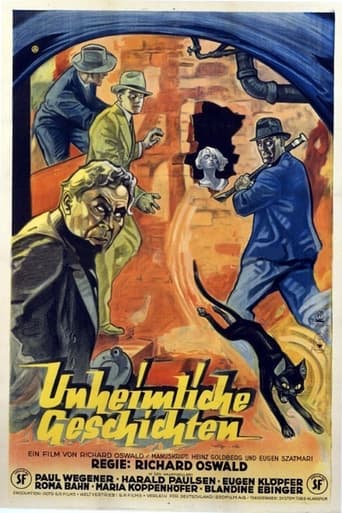

Richard Oswald uses Harald Paulsen as a reporter in pursuit of German horror star Paul Wegener to stitch together three stories. They are Poe's "The Black Cat", his "The System of Dr. Tarr and Professor Fether" (as close as Poe came to a comedy) and Robert Louis Stevenson's "The Suicide Club".Horror was coming into prominence as a movie genre in the early 1930s. Universal Pictures would begin with its production of FRANKENSTEIN. Wegener who had been appearing in this sort of role since the Teens, was a natural, and the similarities of some of the trial sequence here to that of Lang's M, is worth noting. Oswald, like Lang, had to leave the country eventually, but this doesn't have any political content so far as I can see. I know that standard film history would have it that every German movie from about 1924 on is supposed to be a commentary on fascism, but I don't see it.Unfortunately, while the techniques of movie-making and the performances are fine, the movie is padded. Everyone moves slowly in this movie, and the insane move even slower. The sloth may have been intended to allow the audience the terror of anticipation. Unfortunately, it only rouses a sense of impatience. Twenty minutes could have been cut from this movie by movement and some judicious editing.
... View MorePaul Wegener, in his first talkie film, plays an evil inventor who is pursued by investigative journalist (Harald Paulsen) through four famous horror tales. The first is based on Edgar Allen Poe's 'The Black Cat'. Wegener kills his wife and hides her behind a wall in his basement. The reporter, who hears the wife's screams as he is passing by, calls in the police days later after she is reported missing. The journalist and the police eventually find her body thanks to her meowing cat, which was also accidentally walled with the body.The inventor escapes, only to hide in a wax museum (spoofing Paul Leni's 'Waxworks'), where a sinister game of cat and mouse develops. The chase soon moves to an asylum (taken from another Poe story, 'The System of Dr. Tarr and Prof. Fether') and later, to a strange gentlemen's club which runs a sinister suicide game (from Robert Lewis Stevenson's 'The Suicide Club').This is a remake of the director's own 'Eerie Tales' (1919), which also included adaptations of 'The Black Cat' and 'The Suicide Club'. All three stories here have been filmed since as well - 'Tales of Terror' (1962), 'Curse of the Stone Hand' (1964) and 'Dr. Tarr's Torture Dungeon' (1973) stand out as examples – so this may all feel quite familiar. Despite this, it's still very entertaining.The novel approach of linking the separate well-known short stories into one adds a new dimension to the horror anthology sub-genre. It's intended as a spoof of Germany Expressionism, but while it may not exactly have your sides splitting, it still works as a creepy, atmospheric melodrama.It's always fun to see Wegener, whose three silent portrayals of the Golem have ensure his place in horror history. He's great here as the villain; his stony face and narrow eyes make him appear every bit the devious killer. The rest of the less well-known cast do well too.Austrian Director Oswald, who is accredited with directing the first vampire film in 1916 ('A Night of Horror' - now lost), does a fine job of creating a different atmosphere for each story. Of particular note is the 'Dr. Tarr' segment, in which a whole host of lunatics attempt to put our hero on trial.This is a very difficult film to find which is a real shame. Highly recommended for fans of early horror.
... View More